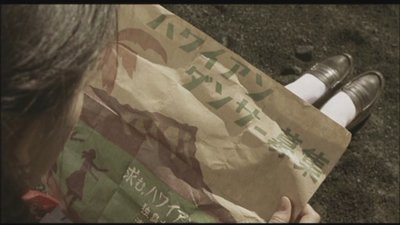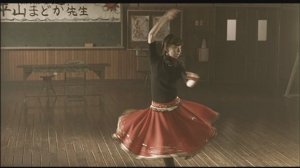| Reviews & Columns |
|
Reviews DVD TV on DVD Blu-ray 4K UHD International DVDs In Theaters Reviews by Studio Video Games Features Collector Series DVDs Easter Egg Database Interviews DVD Talk Radio Feature Articles Columns Anime Talk DVD Savant Horror DVDs The M.O.D. Squad Art House HD Talk Silent DVD
|
DVD Talk Forum |
|
|
| Resources |
|
DVD Price Search Customer Service #'s RCE Info Links |
|
Columns
|
|
|
Hula Girls
VIZ // Unrated // November 6, 2007
List Price: $29.98 [Buy now and save at Amazon]
Winner of the Japanese Academy's Best Picture prize in 2006, Lee Sang-Il's Hula Girls definitely knows how to move. As an iconic dance instructor (Yasuko Matsuyuki) struts onto the floor of the wooden dancing "dojo" near the core of the film's story, half hung over and half reluctant to be in her position, she begins a seemingly unaccompanied routine with unwavering panache. Starry-eyed hula wannabes glare adoringly at her moves, watching her red skirt swirl in the dusty air of the studio. As they observe her dance with hope of escape from their shackled lives in Iwaki, a radiantly sweet and hopeful tone is set for Hula Girls that feels familiar, but nonetheless heartwarming.
The Film:

Iwaki, hometown to the rapidly depleting Joban mines in the mid '60s, is the focus of Hula Girls's true tale. When the mines begin to fade close to closure, peacekeepers trying to outstretch to the town offer a solution: Hawaii. In the outline of the town, plans surface to assemble a Hawaiian resort, called a "Hawaii", which would change the face of its economic draw completely. Packed to the gills with the island traditions, this shift requires a new set of jobs for the entire town. This includes positions for the coal workers as foliage caregivers (gardeners), as greeting specialists, and, most importantly, as alluring hula girls.
After reading a flyer advertising the need for these hula girls, teenage students Kimiko (Yu Aoi) and Sayuri (Shizuyo Yamazaki) heed the allure. Assembled with a bizarre crew of traditional Japanese women and some more, well, colorful additions during an introductory tryout session, Hawaii's flagship executive introduces the hula dancing to the girls, only with a select few open-minded individuals sticking around for the haul. They must overcome the shunning eyes of the town and their families to achieve whatever they can muster as these dancers.
As they fumble and folly with zero training, and the previously mentioned dance instructor stumbles into their hut for the first time, a flurry of uplifting sports movies flood into memory as Hula Girls tip-toes through the motions. Surprisingly similar to Western fairytale sports stories, the film clicks into position with paint-by-numbers familiarity. Think of the demeanors of Western films akin to A League of Their Own and The Bad News Bears, but with grass skirts and hip shaking to boot. Reluctant, innocent talent latch onto a washed-up, drunken pro from times passed in an act of desperation. Expect emotional waves ebbing and flowing all the way between the dancers and their sensei, as well as a few choice training sequences, but imagine it all in a wholesomely harmonized fashion that makes the whole thing sensible.


Hula Girls' course might feel as familiar as glancing at a weathered map to your childhood home, but Lee Sang-Il's film enchants a familiar path with spiraling vivacity. Most of this radiance pours from the big city dance instructor Ms. Hirayama, amiably brought to life by Yasuko Masuyuki. She brings a quirky, attractive essence to the table that begs for bashful attention. Her encounters with the townspeople, especially the bickering arguments her and Kimiko's brother (Etsushi Toyokawa) have, dash a bit of dramatized comedic relief into these scenes. One of the film's rewards comes in this interplay, the see-saw rapport, inside the Joban mine's reluctance to embrace the new opportunity that "Hawaii" brings. The arguments between Ms. Hirayama and the townspeople encapsulate the broader scale quarrel between changing economy and traditional values.
The novice dancers themselves, however, suffer the key conflict in assimilating to a new culture as hula girls. Unlike other Japanese sport films like Sumo Do, Sumo Don't and its message of embracing traditional substance, Sang-Il's take on this true story delves into learning a completely new culture rife with differences to their established comforts. Kimiko, the focal dancer and "leader" of our hula troop, works quite well as an innocent seeker of artistry and freedom. Hula Girls takes her transition towards independent expression for the greater good of this community and blossoms it into a beautifully expansive one. For some, the clockwork sweetness could grow worthy of a few groans and eye rolls, but the thematic flare present manages to usurp these urges more often than not.
Holistically, what makes Hula Girls an enjoyable experience is its native artform. Shot in deliberate sepia tones across the board for an aged photograph feel, its not a bright and boisterous film - until these bright reds and yellows slowly slink into the image. Waiting for color can be a deliberate process; once it surfaces amidst the rattling of instruments and flailing of hips, it falls into a rhythm and never slows down. Of course, the film's tidy elements wrap into a finale that more than satisfies colorful expectations. With that, and all its grandiose performances that eclipse its obviousness, Hula Girls concludes its show as a boisterous and frolicking exercise in saccharine entertainment.
The DVD:


Viz Pictures brings Hula Girls to DVD in a double-disc keepcase presentation with brightly adorned coverart and discart.
The Video:
As mentioned above, Hula Girls' 1.85:1 image becomes dominated with an aged photo look from the get go. This makes the anamorphic widescreen presentation a little difficult to judge, though it still becomes obvious that Viz Pictures succeeds in their effort with this film. It does suffer from a lack of strongly defined detail in several scenes, as well as some light specs akin to pinholes popping up repeatedly. However, in quite a few instances detail and clarity become true assets - especially with close-ups. Though the lingering saturation grows a little tiresome on the eyes after two hours, it still remains visually acute and compelling. Overbearing digitized flaws and blistering edge enhancement steer clear from Hula Girls, making for a very strong visual transfer indeed.
The Audio:
On the aural side, however, Hula Girls is actually a feisty little powerhouse. Presented in a strong Dolby Digital 5.1 surround option, this film blasts to life on more than one occasion The sound effect that had me in awe on several occasions was the replication of footsteps on wood. Nice, hollow thumps echo through the speakers with immense brevity. Each and every surround channel gets plentiful usage, from the presence of rear audience members to the effects of cars driving by. Vocal clarity was also a strong point, but not nearly as strong as the musical accompaniment. Jake Shimabukuro's kitschy score lights up the film, as well as the DVD. Very fine effort from Viz here. An equally strong Dolby surround option is also available.
The Extras:


Viz Pictures serves up a nice plate of supplemental material for Hula Girls, spread across both discs.
- Director and Cast -
General information here is provided for the film's major stars and director, Lee Sang-Il.
- Viz Pictures Presents -
A cluster of other trailers are available here for other Viz Pictures films.
On Disc 2 ... (presented primarily in full-frame)
- The Making of Hula Girls -
This is a 9-minute short featurette on the assembly of the film that's fairly surface level.
- How to be a Hula Girl -
Here's where the core of the good material fazes into the picture. How to be a Hula Girl is a 45 minute (!) featurette on the dancing cast members and their evolution as performers throughout the filmmaking process. It's an emotional, wholly interesting piece that features clips of dedicated choreography work merged with reminiscent pieces from Hayakawa. - Hula Girls: The Real Story -
Adjacent to the dancing piece, Hula Girls: The Real Story features 21 minutes of further discussion from choreographer Hayakawa, as well as other Joban Dance Institute participants, about the original narrative behind the hula girls from 1965. It features a lot of nice interview footage that gives insight into this time period and the dance institute's development that the film didn't address.
- In Interview with Jake Shimabukuru -
This is a short 3-minute interview with the musical composer of the film. He talks a bit about assembling the score for Hula Girls.
- Original Japanese Trailers -
Closing out the supplements are two theatrical trailers, unsubtitled and full of bold colors.
-----
Final Thoughts:
As comfortable as listening to a familiar record you've heard a thousand times over, Hula Girls dances to the beat of the same dancing underdog drummer - but with a lot of likeable flare. Enjoyable performances and a strong musical score set atop this historical true story helps the film waltz rapidly away from obscurity. Packed with a strong visual and aural presentation, Hula Girls culls together a strongly Recommended moniker as a truthful success story with plenty to smile about.
Thomas Spurlin, Staff Reviewer -- DVDTalk Reviews | Personal Blog/Site
The Film:

Iwaki, hometown to the rapidly depleting Joban mines in the mid '60s, is the focus of Hula Girls's true tale. When the mines begin to fade close to closure, peacekeepers trying to outstretch to the town offer a solution: Hawaii. In the outline of the town, plans surface to assemble a Hawaiian resort, called a "Hawaii", which would change the face of its economic draw completely. Packed to the gills with the island traditions, this shift requires a new set of jobs for the entire town. This includes positions for the coal workers as foliage caregivers (gardeners), as greeting specialists, and, most importantly, as alluring hula girls.
After reading a flyer advertising the need for these hula girls, teenage students Kimiko (Yu Aoi) and Sayuri (Shizuyo Yamazaki) heed the allure. Assembled with a bizarre crew of traditional Japanese women and some more, well, colorful additions during an introductory tryout session, Hawaii's flagship executive introduces the hula dancing to the girls, only with a select few open-minded individuals sticking around for the haul. They must overcome the shunning eyes of the town and their families to achieve whatever they can muster as these dancers.
As they fumble and folly with zero training, and the previously mentioned dance instructor stumbles into their hut for the first time, a flurry of uplifting sports movies flood into memory as Hula Girls tip-toes through the motions. Surprisingly similar to Western fairytale sports stories, the film clicks into position with paint-by-numbers familiarity. Think of the demeanors of Western films akin to A League of Their Own and The Bad News Bears, but with grass skirts and hip shaking to boot. Reluctant, innocent talent latch onto a washed-up, drunken pro from times passed in an act of desperation. Expect emotional waves ebbing and flowing all the way between the dancers and their sensei, as well as a few choice training sequences, but imagine it all in a wholesomely harmonized fashion that makes the whole thing sensible.


Hula Girls' course might feel as familiar as glancing at a weathered map to your childhood home, but Lee Sang-Il's film enchants a familiar path with spiraling vivacity. Most of this radiance pours from the big city dance instructor Ms. Hirayama, amiably brought to life by Yasuko Masuyuki. She brings a quirky, attractive essence to the table that begs for bashful attention. Her encounters with the townspeople, especially the bickering arguments her and Kimiko's brother (Etsushi Toyokawa) have, dash a bit of dramatized comedic relief into these scenes. One of the film's rewards comes in this interplay, the see-saw rapport, inside the Joban mine's reluctance to embrace the new opportunity that "Hawaii" brings. The arguments between Ms. Hirayama and the townspeople encapsulate the broader scale quarrel between changing economy and traditional values.
The novice dancers themselves, however, suffer the key conflict in assimilating to a new culture as hula girls. Unlike other Japanese sport films like Sumo Do, Sumo Don't and its message of embracing traditional substance, Sang-Il's take on this true story delves into learning a completely new culture rife with differences to their established comforts. Kimiko, the focal dancer and "leader" of our hula troop, works quite well as an innocent seeker of artistry and freedom. Hula Girls takes her transition towards independent expression for the greater good of this community and blossoms it into a beautifully expansive one. For some, the clockwork sweetness could grow worthy of a few groans and eye rolls, but the thematic flare present manages to usurp these urges more often than not.
Holistically, what makes Hula Girls an enjoyable experience is its native artform. Shot in deliberate sepia tones across the board for an aged photograph feel, its not a bright and boisterous film - until these bright reds and yellows slowly slink into the image. Waiting for color can be a deliberate process; once it surfaces amidst the rattling of instruments and flailing of hips, it falls into a rhythm and never slows down. Of course, the film's tidy elements wrap into a finale that more than satisfies colorful expectations. With that, and all its grandiose performances that eclipse its obviousness, Hula Girls concludes its show as a boisterous and frolicking exercise in saccharine entertainment.
The DVD:


Viz Pictures brings Hula Girls to DVD in a double-disc keepcase presentation with brightly adorned coverart and discart.
The Video:
As mentioned above, Hula Girls' 1.85:1 image becomes dominated with an aged photo look from the get go. This makes the anamorphic widescreen presentation a little difficult to judge, though it still becomes obvious that Viz Pictures succeeds in their effort with this film. It does suffer from a lack of strongly defined detail in several scenes, as well as some light specs akin to pinholes popping up repeatedly. However, in quite a few instances detail and clarity become true assets - especially with close-ups. Though the lingering saturation grows a little tiresome on the eyes after two hours, it still remains visually acute and compelling. Overbearing digitized flaws and blistering edge enhancement steer clear from Hula Girls, making for a very strong visual transfer indeed.
The Audio:
On the aural side, however, Hula Girls is actually a feisty little powerhouse. Presented in a strong Dolby Digital 5.1 surround option, this film blasts to life on more than one occasion The sound effect that had me in awe on several occasions was the replication of footsteps on wood. Nice, hollow thumps echo through the speakers with immense brevity. Each and every surround channel gets plentiful usage, from the presence of rear audience members to the effects of cars driving by. Vocal clarity was also a strong point, but not nearly as strong as the musical accompaniment. Jake Shimabukuro's kitschy score lights up the film, as well as the DVD. Very fine effort from Viz here. An equally strong Dolby surround option is also available.
The Extras:


Viz Pictures serves up a nice plate of supplemental material for Hula Girls, spread across both discs.
- Director and Cast -
General information here is provided for the film's major stars and director, Lee Sang-Il.
- Viz Pictures Presents -
A cluster of other trailers are available here for other Viz Pictures films.
On Disc 2 ... (presented primarily in full-frame)
- The Making of Hula Girls -
This is a 9-minute short featurette on the assembly of the film that's fairly surface level.
- How to be a Hula Girl -
Here's where the core of the good material fazes into the picture. How to be a Hula Girl is a 45 minute (!) featurette on the dancing cast members and their evolution as performers throughout the filmmaking process. It's an emotional, wholly interesting piece that features clips of dedicated choreography work merged with reminiscent pieces from Hayakawa.
Adjacent to the dancing piece, Hula Girls: The Real Story features 21 minutes of further discussion from choreographer Hayakawa, as well as other Joban Dance Institute participants, about the original narrative behind the hula girls from 1965. It features a lot of nice interview footage that gives insight into this time period and the dance institute's development that the film didn't address.
- In Interview with Jake Shimabukuru -
This is a short 3-minute interview with the musical composer of the film. He talks a bit about assembling the score for Hula Girls.
- Original Japanese Trailers -
Closing out the supplements are two theatrical trailers, unsubtitled and full of bold colors.
-----
Final Thoughts:
As comfortable as listening to a familiar record you've heard a thousand times over, Hula Girls dances to the beat of the same dancing underdog drummer - but with a lot of likeable flare. Enjoyable performances and a strong musical score set atop this historical true story helps the film waltz rapidly away from obscurity. Packed with a strong visual and aural presentation, Hula Girls culls together a strongly Recommended moniker as a truthful success story with plenty to smile about.
|
| Popular Reviews |
| Sponsored Links |
|
|
| Sponsored Links |
|
|
| Release List | Reviews | Shop | Newsletter | Forum | DVD Giveaways | Blu-Ray | Advertise |
|
Copyright 2024 DVDTalk.com All Rights Reserved. Legal Info, Privacy Policy, Terms of Use,
Manage Preferences,
Your Privacy Choices | |||||||













